Hello, my intrepid cookie peeps! Welcome to Practice Bakes Perfect Challenge #33. This challenge comes to you thanks to a suggestion by the winner of our last Practice Bakes Perfect Challenge - @talia! Inspired by @iSugarfy (aka swissophie)'s entry to Challenge #32, Talia suggested that we do a challenge involving a very ornate style of overpiping sometimes called Lambeth overpiping. For a quick point of reference, here is the inspiration:
Snow Rabbit Valentine by swissophie
Sonja (aka swissophie) created her Snow Rabbit Valentine set by layering several piped lines, one on top of the other. That layering is what creates the incredible sense of depth that you see. We will talk in a bit about exactly what Lambeth overpiping is and the details for this challenge. But first, let's talk about the fabulous PRIZE we have in store for one lucky challenge entrant!
As always, one lucky entrant will be chosen at random from among all of the challenge entrants. (Remember, the more times you enter the challenge, the greater your chance to win!) And what, you may ask, is our prize for this challenge? It will be a grab bag of goodies (estimated value: $100 USD), donated by Cookie Connection host @Julia M. Usher, containing all manner of piping tools (think: tips, pastry bags, couplers, flower nails, and so forth).
With visions of that terrific prize dancing in your heads, let's talk about the details and rules for this challenge, shall we?
What is Lambeth Overpiping?
When we talk about "overpiping," we are talking about a technique where one pipes two or more lines/layers of icing on top of one another. The technique is believed to have originated centuries ago in Italy as an elaborate cake decorating technique, which then spread throughout Europe (especially France and Germany), and finally to Great Britain. (Other names for this style of ornate overpiping are "European overpiping," "English overpiping", and "Borella overpiping".)
In the early part of the 20th century, an American named Joseph Lambeth learned this overpiping technique, and added some of his own flourishes. He moved to England and started a pastry school called the Lambeth Decorating School, where he became known for his overpiping technique. In 1934, Lambeth published a book titled "Lambeth Method of Cake Decorating and Practical Pastries," wherein he described his style of overpiping.
Since then, many modern pastry chefs have been inspired by the Lambeth Method, updating this style of overpiping for modern audiences. Recently, the wedding cake for William and Kate, Duke and Duchess of Cambridge, was decorated using a modern variation of overpiping. For a more detailed history of the Lambeth Method, check out this blog post by Confectionary Chalet.
As an example of a cake decorated in the Lambeth overpiping style, here is a cake by our own @bobbiebakes:
Although the Lambeth Method was originally almost exclusively used as a method for decorating cakes with royal icing, it is a technique that is perfectly transferable to cookies. Here are a few examples of cookies decorated by fellow Cookie Connection members:
Overpiped Stars by Anikó Vargáné Orbán
White on White by RH. BAKE
Wedding Royal Icing Cookies by Dora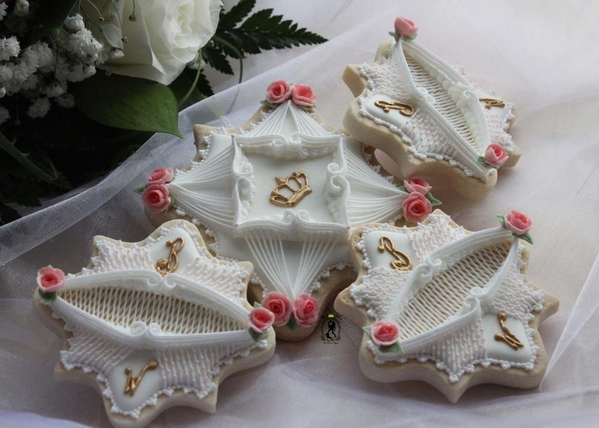
Ornate Cross Cookie by Anita-Vintique Cakes
Lavish Lambeth by Laegwen
As you can see from all of these examples, a pattern or design is created with stiff royal icing and then the pattern is piped over again (and again), using either the same or different styles of tips. The designs can be made with icing that is all one color (as in the example by RH. BAKE, above) or a combination of colors (as in the example by Anikó Vargáné Orbán). Lambeth designs may also incorporate stringwork elements, floral elements, leaves, and other embellishments. The Lambeth Method incorporates many basic piping techniques, such as making shells, snail trails, ropes, barrels, and scrolls. The two most important aspects of Lambeth design are that it be ornate and many-layered.
That sounds a bit complicated, so where do we begin?
For starters, check out this blog post featured on cake-geek.com, which includes a history of the Lambeth Method and overpiping, and some pretty great photos along with links to tutorials: Lambeth Piping - An Introduction.
For excellent instruction on essential piping techniques (like using specialty tips, piping shells and borders, and also overpiping), I highly recommend a series of YouTube videos by award-winning British cake artist Ceri Griffiths. The first one I recommend is called "Border Basics for Royal Icing Video Demonstration". The other videos by Ceri that I suggest are numbered consecutively and titled "A Little Lambeth".
Right here on Cookie Connection, you can even find a few Lambeth-related tutorials. There are two from @bobbiebakes. The first is a tutorial related to the cake shown in the example above. The second is a tutorial for creating these Lambeth-inspired wedding cookies:
And then there is a great tutorial from @Laegwen, showing how to make the Lambeth-inspired borders for these delightful "Sweet Shoppe" cookies (which also happened to be an entry for Practice Bakes Perfect Challenge #16!):
Another tutorial you might find helpful is one by @Anita-Vintique Cakes, which she did for CakesDecor, called "Borella Inspired Piping Tutorial".
There are many other Lambeth-related tutorials available online if you are willing to pay for them. For instance, I ran into some promising-looking ones on Craftsy (now Bluprint), but have not watched any of them myself. I also ran across this short, but quite good online book by Sif Jensen of sifbeth.com called "The Little Book on Royal Icing". The PDF is technically free to view, but the author asks for a voluntary $8 fee if you find it useful. (Pro tip: support our fellow artists, and please do send Sif some money if you use her book.)
- Use stiff piping-consistency royal icing.
- Allow your layers of piped royal icing to at least form a crust before piping the next layer on top. If you fail to do this, the layers will collapse and meld into an amorphous blob of disappointment.
- When stacking your layers of icing, it is easier to start with your larger, wider lines (and tips), and work your way to smaller, narrower lines and tips as you progress from bottom to top. (Stacking piped lines that are all the same size, as shown in our original inspiration photo, Sonja's Snow Rabbit Valentine, requires an extra degree of precision and patience!)
- Since the Lambeth style requires layering extra icing on a cookie, some may find it helpful to add some corn syrup, glucose, or glycerin to the royal icing to ensure a slightly softer bite. (Never tried adding these things to your icing? Then check out this Toolbox Talk by @Liesbet: Corn Syrup in Royal Icing.)
- Do NOT use glaze icing for this challenge! You will never get the stiffness, volume, and height with glaze that you need to create Lambeth designs. (Likewise, I do not recommend using "Frankenfrosting" - icing that is half royal icing and half glaze.)
- Depending on your design, you may find it helpful to create templates or use rulers and/or other tools to create evenly spaced or symmetric patterns. Some of the tutorials I have linked to illustrate how these tools may come in handy.
[Author's Note: As always, if you find additional helpful or interesting tutorials, tips, or other information that may be useful to those of us trying to learn this technique, please share them in the comments under this post. Likewise, thoughtful discussions of your own "fails" are extremely helpful to others - please do not be shy about sharing! Share. ALL. The. Knowledge.]
Rules: PLEASE READ THEM CAREFULLY. Nothing makes me sadder than having to disqualify a fabulous set of cookies because someone failed to read ALL of the rules!
1. Create one large-format cookie (greater than 12.5 centimeters or 5 inches) OR a set of five smaller cookies (each no less than 7 centimeters or 2 3/4 inches) using the Lambeth overpiping technique. (No cakes, please.)
2. The predominant feature of your design (or preferably, your entire design) must be Lambeth overpiping.
3. You must use all royal icing on top of the cookie. Glaze, fondant, and buttercream are not permitted. Sprinkles, dragées, nonpareils, and other embellishments are also not permitted. Painting your royal icing IS permitted.
4. Your design must be completely original, and not a copy of any other artist's design. (In my eyes, the more original the entry, the better! And, remember, no copyrighted designs may be used without written permission.)
5. As always, we ask that you make a brand new cookie OR set of cookies for this challenge.
6. Think outside the box, take some healthy risks, and HAVE SOME FUN.
- Please post an image of your cookie OR cookie set to the site under the Practice Bakes Perfect clip set no later than April 14, 2019 at 5 pm central.
- Because these challenges are ongoing, we ask that you put "Practice Bakes Perfect Challenge #33" in your photo caption AND in a tag, so that we can tell the challenges apart from month to month. Please use the main title field to uniquely name your cookies as you normally would.
- Please also assign other relevant clip sets and tags to your images, as you normally would. (Meaning don't just use the Practice Bakes Perfect clip set and leave it at that, or your photos won't easily be found with keyword searches.)
- You can enter more than once, but please post only one clip of each distinct entry. Multiple clips of the same entry are not allowed unless added in a comment beneath the one primary clip.
After the challenge has closed on April 14, we will announce the winner in the Saturday Spotlight the following weekend (April 20, 2019). The next challenge will be announced about a week after that Spotlight.
And one last thing . . . This is NOT meant to be a competition. The only person you should be competing against is yourself. Period. These challenges are intended to inspire the artist in you and push you to be the best cookie artist YOU can be at this snapshot in time. Remember, the whole point of this exercise is to get you out of your comfort zone - to "take healthy risks," as my wise-beyond-his-years son always reminds me. Plus, prizes are given entirely at random, so healthy risk-taking has its own rewards!
I would love to chat with you as you journey through this process, so if you have any questions about the challenge, are having trouble getting started, need help bringing an idea to life, or want technical advice, please leave a comment below or send me a Cookie Connection private message.
Sources (for "What is Lambeth Overpiping?): Confectionary Chalet; cake-geek.com; Ceri Griffith's YouTube video, "A Little Lambeth #1"

 Christine Donnelly began her professional baking career at 16, when she was hired on the spot at her local bakery to work the counter and decorate cakes. After detours to college and law school, she worked as a trial lawyer in Chicago for many years, ultimately leaving that career to become a stay-at-home mother to her two children. In her “retirement,” she continued to bake at home, at last finding her preferred artistic medium in decorated cookies. In February 2013, Bakerloo Station was born with a presence on both Facebook and Instagram. Christine makes cookies to balance her left brain, to inspire and share creative ideas, and to feed those needs that only art can satisfy.
Christine Donnelly began her professional baking career at 16, when she was hired on the spot at her local bakery to work the counter and decorate cakes. After detours to college and law school, she worked as a trial lawyer in Chicago for many years, ultimately leaving that career to become a stay-at-home mother to her two children. In her “retirement,” she continued to bake at home, at last finding her preferred artistic medium in decorated cookies. In February 2013, Bakerloo Station was born with a presence on both Facebook and Instagram. Christine makes cookies to balance her left brain, to inspire and share creative ideas, and to feed those needs that only art can satisfy.
Photo credit: Christine Donnelly
Note: Practice Bakes Perfect is a bimonthly Cookie Connection blog feature written by Christine Donnelly that poses inspiration or challenges to get you to stretch as a cookie artist - for practice, for prizes, and for fun! Its content expresses the views of the author and not necessarily those of this site, its owners, its administrators, or its employees. Catch up on all of Christine's past Cookie Connection posts here.

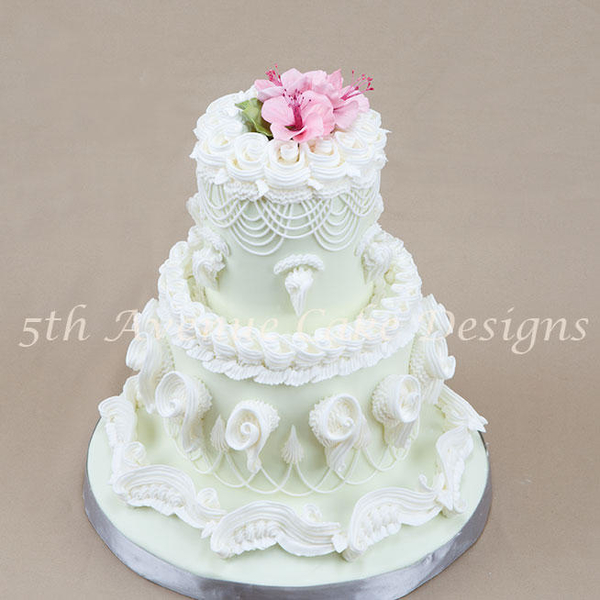



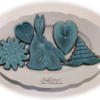

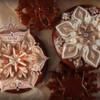

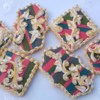

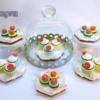
Comments (20)